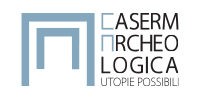Palazzo Muglioni has been a part of Sansepolcro’s history since 1536, as a noble residence at the time. The last noblewoman who lived in this palace, Minerva Muglioni, used to hold cultural salon here. Part of the building was the first headquarters of “Buitoni”, a baked goods company that is still one of the cornerstones of the local economy, today. Then the building became the Carabinieri’s barracks, “caserma” in Italian, and at the end of the 1980s, it was converted into a school, but after that just a long silence.
In 2013, some students of the “Città di Piero” high school, together with Ilaria Margutti – their teacher – entered this place to discover, for the first time, its decadent and fascinating atmosphere. They clean it from all the dust accumulated in 30 years of inactivity, and then organized contemporary art exhibitions, concerts, activities, in an extraordinary bottom-up movement, attracting an intergenerational and proactive community.
At the end of 2015 that spontaneous movement ceased. The Firefighters deemed the building unfit for use due to the inadequate electrical system and, for several months, it seemed impossible to find the funds to fix it. Today we say that the closing report was the greatest opportunity for CasermArcheologica. It forced us to stop that extemporaneous movement and look beyond the crisis of that moment, planning for the medium/long term, putting needs and desires into a system, with an eye for sustainability.
In September 2016, after a long period of planning, the Association won the Culturability open call, promoted by the Unipolis Foundation, which gave us the first funds to start the renovations. Thanks to this victory and other resources from our territory, with the help of the architect Monica Gnaldi Coleschi (Studio Idea +), the Pecorelli’s company and all the artisans fond of the project, we were able to reopen the space on 9th July 2017 with an exhibition called “Agibile” (habitable ed.).
Thanks to Culturability, with Roberta Franceschinelli’s help, we discovered a surprising network that in recent years has been developing around abandoned or underused places, transformed in cultural site of promotion and production, of experimentation with business models, social inclusion, Citizen engagement around common goods. It is a matter of critical debate and concrete practices that involves professionals with hybrid profiles such as: architects, urban planners, artists, jurists, associations, individuals, experts in economics and social policies. Policy makers able to impact upon local dynamics, creating wide networks and projects of broad scope, and building bridges between informal dimensions and the regulatory needs of the institution, in continuous and frequent exchange, trying to be catalyst for other experiences, engaging, in a sense, in a vital form of Humanism.
CasermArcheologica, together with many other Italian stories of urban regeneration, shows that there are at least two generations of people with the desire and ability to start afresh from the neglected artistic heritage and human capital, and to create value around them.
It is a process of progressive growth, project by project, room by room, a continuous search for meaning, shared with the community. The spaces of the former barracks, its history and its cracks, witnesses of the stratification of time, inspire us and guide our work inside and outside its walls.
Every day we ask ourselves who will live in these places, the Valtiberina, in five years, what our desires and jobs will be then. In asking and sharing these questions, which we feel are the most urgent in our time, we follow the path of culture and work, in a continuous flow of practices and at the same time translating into awareness, because the activities of CasermArcheologica may also be interrupted, but the thinking will always be generative, beyond ourselves and beyond the extraordinary experience that CasermArcheologica has been gifting us.
Laura Caruso and Ilaria Margutti

CasermArchelogica Association, 9 founders:
Ilaria Margutti (1971) teacher and artist, Laura Caruso (1979) project manager, Luca Giovagnoli (1980) technician, Monica Gnaldi Coleschi (1975) architect, Saverio Verini (1985) curator, Giulia Grassini (1990) museum managment, Marco Mercati (1986), businness owner and artist, Roberta Panichi (1985) educator, Giacomo Calli (1987) phonic.
New Executive, since November 2021
Ilaria Margutti (1971) President
Ruben Marzà (1993)
Andrea Marsili (1998)
Lucia Scartoni (1998)
Gianmarco Foni (2002)
Cecilia Colagiovani (2002)
Giulia Bilancetti (1988)

